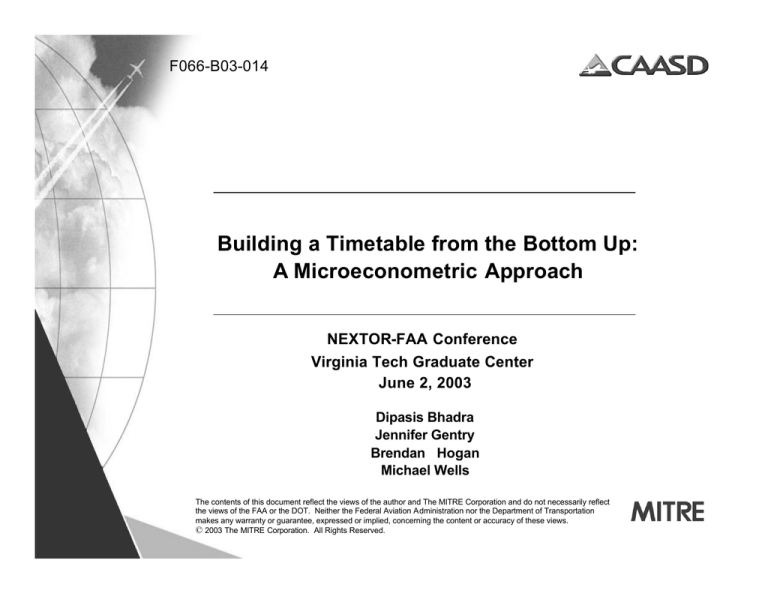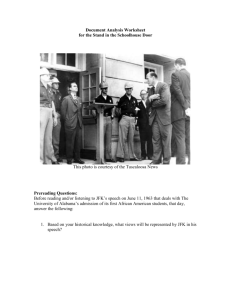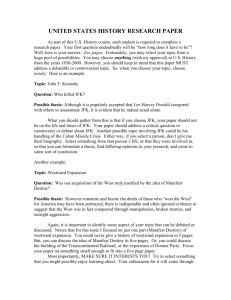
F066-B03-014
Building a Timetable from the Bottom Up:
A Microeconometric Approach
NEXTOR-FAA Conference
Virginia Tech Graduate Center
June 2, 2003
Dipasis Bhadra
Jennifer Gentry
Brendan Hogan
Michael Wells
The contents of this document reflect the views of the author and The MITRE Corporation and do not necessarily reflect
the views of the FAA or the DOT. Neither the Federal Aviation Administration nor the Department of Transportation
makes any warranty or guarantee, expressed or implied, concerning the content or accuracy of these views.
© 2003 The MITRE Corporation. All Rights Reserved.
Our Product: A Flight Timetable (or Schedule)
Based on Projected Future Demand
Departure Airport
Arrival Airport
Equipment
Departure Time (GMT)
Arrival Time (GMT)
JFK
CUN
B752
3:40:00 PM
7:47:00 PM
JFK
DCA
E145
3:50:00 PM
JFK
FLL
A320
3:45:00 PM
JFK
IAD
JS41
3:57:00 PM
Weekday 5:05:00 PM
6:40:00 PM
2004, Q45:26:00 PM
HGR
TEB
PAY4
4:00 PM
JFK
IAD
CRJ1
JFK
KIN
A343
JFK
LAS
B752
3:30:00 PM
9:01:00 PM
JFK
3:10:00 PM
9:15:00 PM
3:30:00 PM
9:23:00 PM
JFK
B762
Weekday
LAX
B763
MCO2018, Q2
A320
3:45:00 PM
6:25:00 PM
JFK
MCO
B752
3:25:00 PM
6:11:00 PM
JFK
Weekend OAK
PAP
20xx, Qx PBI
A320
3:40:00 PM
10:15:00 PM
A306
3:00:00 PM
6:53:00 PM
A320
3:30:00 PM
6:20:00 PM
LAX
JFK
JFK
JFK
2
F066-B03-014
Weekend
3:15:00 PM
3:15:00 PM
2006, Q3
6:05:00 PM
4:31:00 PM
7:05:00 PM
© 2003 The MITRE Corporation. All Rights Reserved.
The Usual Method: Top-Down Forecasts
• Starts with national-level macro drivers, and allocates
regional effects, if necessary.
• Straightforward process that works well in projecting longterm trends.
• However, because macro factors are the primary “drivers”,
regional differences are often missed.
• No network effects.
3
F066-B03-014
© 2003 The MITRE Corporation. All Rights Reserved.
Our Method: A Multi-Step Approach,
Going from the Bottom Up
Estimate O&D
Passenger
Demand
4
F066-B03-014
Calculate Total
“Segment”
Passengers
Estimate the
Number & Size of
A/C by Segment
Create Timetable
for Scheduled
and Unscheduled
© 2003 The MITRE Corporation. All Rights Reserved.
Step 1: Estimating O&D Demand
Estimate O&D
Passenger
Demand
5
F066-B03-014
© 2003 The MITRE Corporation. All Rights Reserved.
Determinants of Air Travel Demand
Between O&D Pairs: Conceptual Framework
One-Way Fare ($)
between O&D Pairs
Note: Bold lines represent directional certainty.
Therefore, while personal income is certain to
increase demand, bad weather is certain to reduce
it.
Dashed lines represent ambiguity. Large hubs, will
certainly increase passenger flow but may
eventually reduce it after a certain point.
Personal
Income
Population,
Density
Interactions
Large Hub
Market Shares
Southwest
Presence
Distance
traveled
Bad weather
D: O&D Demand
between City-Pairs
Average No. of
Passengers/Day
Source: Bhadra, D. (2003). “Demand for Air Travel in the United States: Bottom-Up Econometric
Estimation and Implications for Forecasts by O&D pairs”, Journal of Air Transportation (forthcoming).
6
F066-B03-014
© 2003 The MITRE Corporation. All Rights Reserved.
Combining DOT Passenger Data with
Local Economic and Demographic Forecasts
Airline Passenger Data
Local Economic Data
10% Ticket Sample
2000:1 - 2001:2
Demographic Data
1975:1 - 2025: 4
• Passengers
• Fare
• Population
• Carrier(s)
• Income
• Exact Itinerary
• Employment
• Miles flown
• Airports
• Metropolitan Areas
7
F066-B03-014
© 2003 The MITRE Corporation. All Rights Reserved.
Basic Econometric Framework
Example of Data Set
Year Qtr Origin
Destination
Distance Pax
Fare Origin_pop
2000
1 ALBANY, NY, USA BUFFALO, NY, USA
251
158
139
869,474
2000
1 BINGHAMTON, NY, USA
PITTSBURGH, PA, USA
251
14
220
2000
1 CHICAGO, IL, USA ST. LOUIS, MO, USA
251 2,503
88
8,008,507
2000
1 DENVER, CO, USA DURANGO, CO, USA
251
76
161
1,978,991
2000
2 ALBANY, NY, USA BUFFALO, NY, USA
251
155
154
869,474
2000
2 BINGHAMTON, NY, USA
PITTSBURGH, PA, USA
251
20
186
2000
2 CHICAGO, IL, USA ST. LOUIS, MO, USA
251 2,718
94
8,008,507
2000
2 DENVER, CO, USA DURANGO, CO, USA
251
85
164
1,978,991
Basic Econometric Specification
Semi Log-Linear Specification
(Segmented by Observed Distances in the NAS)
ln (Pij) = α + β * ln(fij) + χi * ln(PIi)+ χj * ln(PIj)
+ δi * ln(Densityi) + δj * ln(Densityj)
+ φi * ln(Interactionsi) + φj * ln(Interactionsij)
+ η * ln(Market PowerDij) + ι * ln(Market PowerNDij)
+ κD * (Southwest ij) + κND * (Southwest ij)
+ γi * (hub statusOrigin) + γj * (hub statusDestination)
+ ϕ * ln(Distanceij)+ ρ * (season) + εij
8
F066-B03-014
© 2003 The MITRE Corporation. All Rights Reserved.
Comparison with Top-Down Forecasting
l
e
a
d
s
t
o
9
Market Features
Price Elasticities
Income Elasticities
Distance Elastiticities
Seasonality
Low-cost carriers
Industry concentrations
Local economies, &
demographies
Existing & FAA
work
Our Research
uses one general number
economy-wide(GDP) general number
does not incorporate
does not incorporate
part of anti-trust evaluation procedure
part of anti-trust evaluation procedure
does not incorporate
effects are evaluated by distance bands
effects are evaluated by distance bands
effects are evaluated by distance bands
effects are evaluated by distance bands
effects are evaluated by distance bands
effects are evaluated by distance bands
effects are evaluated by distance bands
Improved
benefit assessment
Evaluation of future
infrastructure for a
particular airport
Assessment
of policy changes,
e.g., demand mgmt
policies on airports
Evaluations of effects of
low-cost carriers by
market distances
F066-B03-014
Evaluations of spring/
summer
on scheduled air
transportation
Evaluations of market
structures on scheduled
air transportation
© 2003 The MITRE Corporation. All Rights Reserved.
Step 2: Estimating Segment Demand
Calculate Total
“Segment”
Passengers
10
F066-B03-014
© 2003 The MITRE Corporation. All Rights Reserved.
Assign OD Passengers to Routes
Based On Relative Desirability
SEA
BOS
ORD
50
30
50
30
“Desirability” is based on route characteristics,
such as block time and number of stops.
DFW
We calibrate passenger
choice by applying a
“Logit” model to data from the 10% Ticket Sample.
11
F066-B03-014
© 2003 The MITRE Corporation. All Rights Reserved.
Estimate Each Market in Turn,
Adding Up Passengers on Each Segment
SEA
50 + 60
BOS
ORD
50
30
30 + 70
60
MIA
70
DFW
12
F066-B03-014
© 2003 The MITRE Corporation. All Rights Reserved.
At the End, We Arrive at an Estimate of
Total Passengers by Airport Pair
SEA
BOS
ORD
110
150
100
230
200
160
LAX
MIA
300
DFW
13
F066-B03-014
170
© 2003 The MITRE Corporation. All Rights Reserved.
Step 3: Estimate Aircraft Used by Segment
Estimate the
Number & Size of
A/C by Segment
14
F066-B03-014
© 2003 The MITRE Corporation. All Rights Reserved.
Distribution of Passengers by A/C Category
(Cumulative total > 90%)
Share of AC Categories in Total Enplanement of Scheduled Air Transportation
80.00%
70.00%
1997
60.00%
1998
1999
2000
2001
% of enplanement in total
50.00%
40.00%
30.00%
20.00%
10.00%
0.00%
Category 1
Category 2
Category 3
Category 4
Category 5
categories
15
F066-B03-014
Source: T-100 Segment Data; DOT/BTS
© 2003 The MITRE Corporation. All Rights Reserved.
Type of Aircraft in Each of Five Categories
16
Types of A/C
TurboProps
TurboProps
TurboProps
Types of Equipment
SF-340 SAAB-Fairchild 340
ATR-72 ATR-72 Aerospatial
ATR-42 ATR-42 Aerospatial
Narrow Body
Narrow Body
Narrow Body
EMB-145 Embraer EMB-145
DC-9-50 Douglas DC-9-50
RJ-145 Canadair RJ145-200
Narrow Body
Narrow Body
Narrow Body
Narrow Body
Narrow Body
Narrow Body
Narrow Body
B-737-3/7 Boeing B-737-300
MD-80 MD-80 & DC-9-80 Al
B-727-2 Boeing B-727-200/2
B-737-1/2 Boeing B-737-100/
DC-9-30 Douglas DC-9-30
B-737-5 Boeing B-737-500
B-737-4 Boeing B-737-400
Narrow Body
Narrow Body
A319 Airbus Industrie A
B737-7/LR Boeing B-737-700/
Wide Body
Wide Body
Wide Body
Wide Body
Wide Body
Wide Body
B-747-4 Boeing B-747-400
B-757-2 Boeing B-757-200
B-767-2/ER Boeing B-767-200
B-777 Boeing 777
B-767-4 Boeing B-767-400
L-1011-5 Lockheed L-1011-50
F066-B03-014
Broad
Category
Category 1
Avg. Distance Avg. Size Range
Best Cruise
Service
(miles)
(no. of pax)
Speed (MPH)
Status
< 250
30-37
328 Production Terminated
< 250
60-72
319
-< 250
43-53
345
--
Category 2
250-500
250-500
250-500
45-55
122-148
45-55
Category 3
500-750
500-750
500-750
500-750
500-750
500-750
500-750
114-138
122-148
131-156
93-113
91-121
91-121
132-162
750-1500
750-1500
112-136
113-139
> 1500
> 1500
> 1500
> 1500
> 1500
> 1500
416-568
178-239
162-199
305-365
245-303
?
Category 4
Category 5
566 in service
586 Production terminated
566 in service
566
576
600+
586
586
566
566
-Production terminated
Production terminated
Production terminated
590
600 --
1996
700 April, 1988
600+
700
© 2003 The MITRE Corporation. All Rights Reserved.
From Passenger Demand to Aircraft Operations by
Market Segment: A Qualitative Choice Framework
Qualitative Choice of
Determining Aircraft
using
T100 Segment Data
by Stage Lengths for
1992-2002
Estimated Passenger
Demand & Forecasts
Demand
for
Passenger
Aircraft by
Categories
Category 1
Category 2
Category 3
Category 4
Category 5
Process of Demand Generation: Passengers to A/C
Movements by Market Routes and Stage Lengths
17
1.
Define the markets by stage lengths, i.e. short -haul (<1200 miles), medium-haul
(<2000 miles) and longer hauls.
2.
Classify aircraft into categories from the disaggregated list of almost 70 distinct
A/C types over the last 5 years.
F066-B03-014
© 2003 The MITRE Corporation. All Rights Reserved.
Step 4: Create a Timetable of Flights
Create Timetable
for Scheduled
and Unscheduled
18
F066-B03-014
© 2003 The MITRE Corporation. All Rights Reserved.
Final Timetable: Description of components
Departure Airport
Arrival Airport
Equipment
Departure Time (GMT)
Arrival Time (GMT)
JFK
CUN
B752
3:40:00 PM
7:47:00 PM
JFK
DCA
E145
JFK
FLL
JFK
Time of Day
3:50:00 PM
5:05:00 PM
A320
3:45:00 PM
6:40:00 PM
IAD
JS41
3:57:00 PM
5:26:00 PM
JFK
IAD
CRJ1
3:15:00 PM
4:31:00 PM
JFK
KIN
3:15:00 PM
7:05:00 PM
Airport D
JFK
Airport A
A343
LAS
B752
3:30:00 PM
9:01:00 PM
JFK
LAX
B762
3:10:00 PM
9:15:00 PM
JFK
LAX
B763
3:30:00 PM
9:23:00 PM
JFK
MCO
A320
3:45:00 PM
6:25:00 PM
JFK
MCO
B752
3:25:00 PM
6:11:00 PM
JFK
OAK
A320
3:40:00 PM
10:15:00 PM
JFK
PAP
A306
3:00:00 PM
6:53:00 PM
Frequency
Flight Segments
Aircraft
Block Time
JFK
PBI
A320
3:30:00 PM
6:20:00 PM
JFK
PBI
B732
3:25:00 PM
6:28:00 PM
JFK
IAD
JS41
3:57:00 PM
5:26:00 PM
HGR
TEB
PAY4
4:00 PM
6:05 PM
JFK
PHX
A320
3:00:00 PM
8:24:00 PM
Block
time
O&D
will
be historically
estimated
T100percent
data and
Initially
derived
using
15-minute
weighted
291
Airports
–by63%
of pairs
TAF
Airports,
95% of using
2000
Enplanements
Variable
derived
by applying
a Load
Factor
to the
AC Chosen
route
adjusting
for Additional
schedule.
distribution.
criteria
will
be added
asAT
time
permits.forineach
(remainder
primarily
non-CONUS),
80%
AC and
operations
2000
19
F066-B03-014
© 2003 The MITRE Corporation. All Rights Reserved.
00
20
0:00
0:00
0:00
0:00
0:00
0:00 0:39
0:38
0:38
0:38
0:38
0:38 1:18
1:16
1:16
1:16
1:16
1:16 1:57
1:54
1:54
1:54
1:54
1:54 2:36
2:32
2:32
2:32
2:32
2:32 3:15
3:10
3:10
3:10
3:10
3:10 3:54
3:48
3:48
3:48
3:48
3:48 4:33
4:26
4:26
4:26
4:26
4:26 5:12
5:04
5:04
5:04
5:04
5:51
5:04
5:42
5:42
5:42
5:42
6:30
5:42
6:20
6:20
6:20
6:20
7:09
6:20
6:58
6:58
6:58
6:58
7:48
6:58
7:36
7:36
7:36
7:36
8:27
7:36
8:14
8:14
8:14
8:14
9:06
8:14
8:52
8:52
8:52
8:52
9:45
8:52
9:30
9:30
9:30
9:30
10:24
9:30
10:08
10:08
10:08
10:08
10:0811:03
10:46
10:46
10:46
10:46
11:42
10:46
11:24
11:24
11:24
12:21
11:24
11:24
12:02
12:02
12:02
13:00
12:02
12:02
12:40
12:40
12:40
13:39
12:40
12:40
13:18
13:18
13:18
14:18
13:18
13:18
13:56
13:56
13:56
14:57
13:56
13:56
14:34
14:34
14:34
15:36
14:34
14:34
15:12
15:12
15:12
16:15
15:12
15:12
15:50
15:50
15:50
16:54
15:50
15:50
16:28
16:28
16:28
17:33
16:28
16:28
17:06
17:06
17:06
18:12
17:06
17:06
17:44
17:44
17:44
18:51
17:44
17:44
18:22
18:22
18:22
19:30
18:22
18:22
19:00
19:00
19:00
20:09
19:00
19:00
19:38
19:38
19:38
20:48
19:38
19:38
20:16
20:16
20:16
21:27
20:16
20:16
20:54
20:54
20:54
22:06
20:54
20:54
21:32
21:32
21:32
22:45
21:32
21:32
22:10
22:10
22:10
23:24
22:10
22:10
22:48
22:48
22:48
22:48
22:48
23:26
23:26
23:26
23:26
23:26
Schedules are Different - December 12, 2002
Count on Y Axis is the Number of Operations in Next 30 Minutes
1st Tier Airports –SMX
34 OAG
(benchmark
except
HNL,
many
carriers
– including
JFK
OAG
Scheduled
Scheduled
Operations
Operations
(4th
Tier)
ATL
OAG
Scheduled
Operations
LGA
OAG
Scheduled
Operations
MRY
OAG
Scheduled
Operations
(3rd
Tier)
SMF
OAG
Scheduled
Operations
(2nd
Tier)
LCC,
average 117 cities served, average 15 countries served)
3
35
80
35
5
12
nd Tier Airports – 93 (5 or more carriers – includes some LCC, average 27
2
70
30
30
cities served – few serve other countries)
10
4
60 rd
25
25
2
3 Tier Airports
DEP
– 86 (2-3 passenger carriers, average 7 cities)
th
50 8
3
20
20
40
15
15
2
30
1
6
ARR
ARR
4 Tier ARR
Airports
– 78 (1 passenger carrier, average 3 cities)
DEP
DEP
ARRARR
DEP
ARR DEP
DEP
10 4
10
20
1
5
2
10
5
0
00
F066-B03-014
© 2003 The MITRE Corporation. All Rights Reserved.
Creating a Timetable for Scheduled Flights
Forecast Future Flights
Past OAG Schedule
• Includes flight time info
• Origin, Dest, A/C Type
• Need times added
to complete schedule
Scheduled Traffic Timetable
21
JFK
CUN
Cat 5
3:40:00 PM
7:47:00 PM
JFK
DCA
Cat 2
3:50:00 PM
5:05:00 PM
JFK
FLL
Cat 4
3:45:00 PM
6:40:00 PM
JFK
IAD
Cat 2
3:57:00 PM
5:26:00 PM
F066-B03-014
© 2003 The MITRE Corporation. All Rights Reserved.
Finally We Add Unscheduled Flights
Forecasted Future Flights
Past OAG Schedule
Unscheduled Traffic
• IFR
• VFR
Final Traffic Timetable
22
JFK
CUN
Cat 5
3:40:00 PM
7:47:00 PM
JFK
DCA
Cat 2
3:50:00 PM
5:05:00 PM
JFK
FLL
Cat 4
3:45:00 PM
6:40:00 PM
JFK
IAD
Cat 2
3:57:00 PM
5:26:00 PM
HGR
TEB
Cat 1
4:00 PM
6:05 PM
F066-B03-014
© 2003 The MITRE Corporation. All Rights Reserved.
Unscheduled Traffic Timetable Development
All Scheduled & Unscheduled Traffic
Definition:
Any air traffic not listed in the Official
Unscheduled
Traffic
by Airport
& IFR)
Airline Guide.
This
traffic(VFR
typically
includes: business, leisure, cargo, and Detailed enough for
schedule forecasting
charter operations.
Unscheduled IFR Traffic
Unscheduled Traffic by Airport (VFR)
Not detailed
enough for
schedule
forecasting
Reality Check
With local TAF Ops
23
F066-B03-014
© 2003 The MITRE Corporation. All Rights Reserved.
Our Product: A Flight Timetable (or Schedule)
Based on Projected Future Demand
Departure Airport
Arrival Airport
Equipment
Departure Time (GMT)
Arrival Time (GMT)
JFK
CUN
B752
3:40:00 PM
7:47:00 PM
JFK
DCA
E145
3:50:00 PM
JFK
FLL
A320
3:45:00 PM
JFK
IAD
JS41
3:57:00 PM
Weekday 5:05:00 PM
6:40:00 PM
2004, Q45:26:00 PM
HGR
TEB
PAY4
4:00 PM
JFK
IAD
CRJ1
JFK
KIN
A343
JFK
LAS
B752
3:30:00 PM
9:01:00 PM
JFK
3:10:00 PM
9:15:00 PM
3:30:00 PM
9:23:00 PM
JFK
B762
Weekday
LAX
B763
MCO2018, Q2
A320
3:45:00 PM
6:25:00 PM
JFK
MCO
B752
3:25:00 PM
6:11:00 PM
JFK
Weekend OAK
PAP
20xx, Qx PBI
A320
3:40:00 PM
10:15:00 PM
A306
3:00:00 PM
6:53:00 PM
A320
3:30:00 PM
6:20:00 PM
LAX
JFK
JFK
JFK
24
F066-B03-014
Weekend
3:15:00 PM
3:15:00 PM
2006, Q3
6:05:00 PM
4:31:00 PM
7:05:00 PM
© 2003 The MITRE Corporation. All Rights Reserved.
F066-B03-014
Backup Slides
The contents of this document reflect the views of the author and The MITRE Corporation and do not necessarily reflect
the views of the FAA or the DOT. Neither the Federal Aviation Administration nor the Department of Transportation
makes any warranty or guarantee, expressed or implied, concerning the content or accuracy of these views.
© 2003 The MITRE Corporation. All Rights Reserved.
“Bottom-up” city-pair approach reveals network effects.
Aggregates can be compared with forecasts from TAF.
Economists have advised the FAA to use O-D ticket data to capture network effects.
10% Ticket Sample
City-pair analyses
Regression
Passenger demand
by city pair
•
•
•
•
Local and national economics
Spring-summer seasonality
New runways, airports
Fares
Flight estimates by airport
with network relationships
Aircraft Fleets
Regional Demographics
and Economics
Generate “bottom-up”
NAS-wide estimate
(Consistency check)
“Top-down” estimate
26
F066-B03-014
© 2003 The MITRE Corporation. All Rights Reserved.
Nation’s top MSAs: How are passengers
allocated at multi-airport MSAs?
Passenger Enplanement at New York Metro
2.10%
Passenger Enplanement at Washington DC Metro
0.00%
27.70%
31.78%
37.24%
Downtown Manhattan Heliport
John F Kennedy International
LaGuardia
West 30th St. Heliport
Newark
Long Island-MacArthur
40.73%
Dulles International
Washington National
Baltimore/Washington Intl
The present allocation can be used, as a first approximation,
for future traffic allocation as well. However, as the industry
restructures, more low-cost and regional carriers emerge,
Passenger Enplanement at Chicago MSA
and secondary airports become competitive, a new
allocation of traffic is likely. Thus, it is important to model
airport choice correctly.
29.47%
0.00%
30.98%
Passenger Enplanement at Los Angeles/Burbank/Long Beach MSA
0.00%
12.01%
0.00%
0.00%
7.80%
1.04%
16.31%
El Toro MCAS
Hollywood-Burbank
Long Beach
Dupage County
Midway
O’Hare International
Palwaukee
Los Angeles International
Orange County
83.69%
79.14%
27
F066-B03-014
© 2003 The MITRE Corporation. All Rights Reserved.
% share
Airport Assignments
Rules for 1st Approximation: 27 MSAs together account for 75% of ALL
scheduled enplanements today; 19 of those MSAs have multiple airports.
Together they account for 60% of ALL scheduled enplanements
9.00%
8.00%
7.00%
6.00%
5.00%
4.00%
3.00%
2.00%
1.00%
0.00%
Percentage share in total enplanements by large hubs
...
l
of Co
Lake
te &
strict
arwa
n, Di
g/Cle
ingto
rsbur
Wash
e
t
St. Pe
ton
pa &
shing
Tam
, Wa
coma
le/Ta
d, CA
Seatt
aklan
sco/O
ranci
San F
ornia
Calif
iego,
San D
uri
Misso
ouis,
St. L
a
rizon
NJ
nix, A
den,
Phoe
/Cam
ia, PA
delph
Phila
York
ida
, New
, Flor
York
rdale
New
aude
..
i/Ft. L
/Lon.
Miam
bank
s/Bur
ngele
Los A
da
Neva
egas,
Las V
exas
ton, T
aii
Hous
, Haw
Oahu
lulu,
Hono
an
ichig
it, M
xas
Detro
h, Te
Wort
s/Ft.
Dalla
io
i, Oh
innat
Cinc
s
llinoi
ago, I
Chic
a
eorgi
ta, G
Atlan
Note: DOT-defines large hub airports as those having
1% or more of total enplanements.
28
Source: http://www.bts.gov/publications/airactstats/tables/AirportTable3.htm
F066-B03-014
2003 The multiple
MITRE Corporation.
All Rights Reserved.
MSAs© with
airport
nodes
Aircraft Assignments by O&D pair:
How are passengers allocated today?
Broad A/C Departure Categories in the NAS:
2000 (sept)
14%
0%
2%
Rank
7%
Turbo-Prop
Piston
Jet-4/6 Engine
Jet-3 Engine
Jet-2 Engine
77%
200000
180000
18000000
16000000
14000000
160000
No. of departures
12000000
No. of Passengers
120000
10000000
100000
8000000
Passengers
No. of Dep.
140000
A/C type
1 B-737-8/9 Boeing B-737 series
2 MD-90/87/80/ series
3 B-757-2 Boeing B-757 series (all included)
4 DC-9-Series (50, 40, 30, 15, 10)
5 Embraer Series (EMB-145, 135, 120)
6 A3XX series Airbus Industrie
7 B-727-QC Boeing B-727 series
8 SF-340 SAAB-Fairchild 340
9 RJ-145 Canadair RJ145-200
10 ATR-72 ATR-72 Aerospatial
11 B-767-4 Boeing B-767 series (all included)
12 DHC8-100 De Havilland DHC 8
13 AVRO-RJ85 Avroliner RJ85
14 JETST-41 British Aero. BAE
15 DO-328T Dornier 328 Turbo
16 BAE-146-3 British Aero. BAE
17 DC-10-4 Douglas DC-10-40 TO 10-10
18 L-1011-5 Lockheed Series
19 B-777 Boeing 777
20 B-747-F Boeing B-747series
21 PA-32 Piper PA-32
22 C-208 Cessna 208
23 FALCON Dassault Falcon
24 MD-11 Douglas MD-11
25 L-188A Lockheed L-188A-08
Total
199,297
84,302
48,673
47,883
41,049
37,207
36,609
34,113
29,573
18,863
13,245
9,376
6,249
4,922
4,617
3,762
3,249
1,799
1,772
692
190
187
164
146
131
628,070
16,060,781
7,508,323
5,907,629
2,998,687
977,485
3,348,562
3,330,755
613,905
939,895
552,571
1,933,688
195,606
247,068
74,399
83,997
179,945
697,599
375,086
329,985
126,247
177
50
0
20,515
2,797
46,505,752
Avergare
Distance
(in miles)
The present allocation (by O&D) can be used, as a first
approximation, for future traffic allocation as well. However,
an improved estimation technique (based on probabilistic
choices) will be used to estimate fleet choice by O&D pairs.
Top 10 A/Cs in the NAS
220000
Departures
Total
Perfomed by Broad No. of
A/C category Passengers
80000
6000000
60000
4000000
675
598
1152
525
359
1034
672
205
435
215
1344
206
343
206
238
399
1635
1571
1258
1745
142
80
583
2035
361
721
40000
2000000
20000
0
0
B-737-8/9 MD-90/87/80/ B-757-2 Boeing DC-9-Series Embraer Series A3XX series
B-727-QC SF-340 SAABBoeing B-737
series
B-757 series (50, 40, 30, 15, (EMB-145, Airbus Industrie Boeing B-727 Fairchild 340
series
(all included)
10)
135, 120)
series
29
F066-B03-014
RJ-145
ATR-72 ATR-72
Canadair
Aerospatial
RJ145-200 types of A/Cs (Sept. 2000)
Total A/C Types = 68
year = 2000; Month = 9;
Source Data: T-100 segment data
© 2003 The MITRE Corporation. All Rights Reserved.
Total passengers that are flown in the NAS by different aircraft
700,000
70,000,000
680,000
60,000,000
660,000
50,000,000
640,000
40,000,000
620,000
30,000,000
Total A/C Ops
600,000
20,000,000
Total Pax
F066-B03-014
De
c
No
v
Oc
t
Se
pt
Au
gu
st
Jul
y
Ju
ne
M
ay
0
Ap
ril
560,000
M
arc
h
10,000,000
Fe
bru
ary
580,000
Ja
nu
ary
30
Monthly Segment Pax
Monthly A/C Ops
A/C Ops and Total Passengers
Segment Data: T-100
Months_2000
© 2003 The MITRE Corporation. All Rights Reserved.
Distribution of active jets fleets
750
700
650
600
550
500
450
400
350
300
250
200
150
100
50
0
Active Jet Fleets in the US (01/2003)
N = 3623
705
550
521
424
289
271
206
167
129
83
40
31
74
50
3
15
24
32
9
0
10
F0
1
33
32
AA0&
8
32
A31
A&
19
A3
0
30
/40
A/30
-10
-10
DC
11
DM
0
20
771
/90
80
D- 0H
M
/5
30
-9DC
0
20
777
0
40
/3/
7-2 0
76
0
0/3
20
775
0
40
70
74
/20
00
7-1 00
74
9
/8/
6/7
70
73
/50
3/4
7H
73
00
0/2
10
773
0H
20
773
Jets
31
F066-B03-014
Source: Airline Monitor: February/March, 2003
© 2003 The MITRE Corporation. All Rights Reserved.
Distribution of active RJ fleets
Active RJs in the US
(N = 1020)
600
503
500
430
400
300
200
100
53
34
0
CRJ
32
F066-B03-014
EMB RJ
Source: Airline Monitor: February/March, 2003
BAE146 RJ85
DO328
© 2003 The MITRE Corporation. All Rights Reserved.
From Passenger Demand to Demand for Aircraft Operations by
Market Segments:
A Suggested Framework (contd.)
Qualitative Choice of
Determining Aircraft
using
T100 Segment Data
by Stage Lengths for
1991-2000
Estimated Passenger
Demand & Forecasts
Demand
for
Passenger
Aircraft by
Class
Category 1
Category 2
Category 3
Category 4
Category 5
Process of Demand Generation: Passengers to A/C
Movements by Market Routes and Stage Lengths
3. Based on the data (> 2 million records for 1992-2001), i.e., T100 segment data, we ask the qualitative question:
(a) What is the probability that one category of aircraft will be chosen over others given airline characteristics,
market characteristics, no. of passengers, proportion of non-passengers (i.e., mail, freight) to passengers, and other
performance indicators, such as departure scheduled and performed, elapsed time ramp-to-ramp and airborne,
distance, year, and quarter.
(b) From these statistical estimates of probabilities of 5 qualitative choices, we determine the number of aircraft by
O&D pairs.
(c) We also evaluate the effects of different factors (e.g., effects of market or airline characteristics, or quarters, or
performance) in the probabilistic choices of aircraft.
(d) Finally, we use the forecasted passenger numbers, holding all other factors constant, to generate the forecast of
aircraft (i.e., Future Demand).
33
F066-B03-014
© 2003 The MITRE Corporation. All Rights Reserved.






